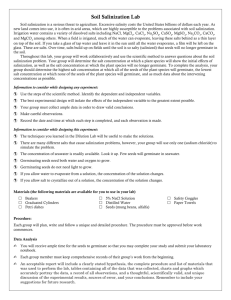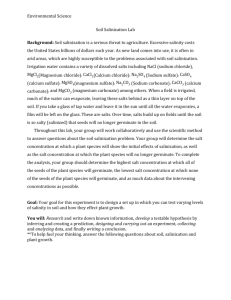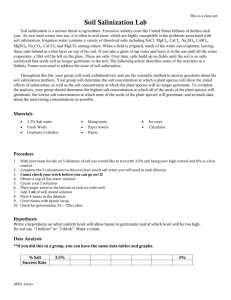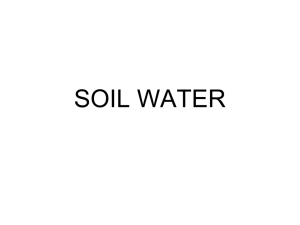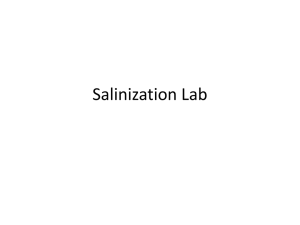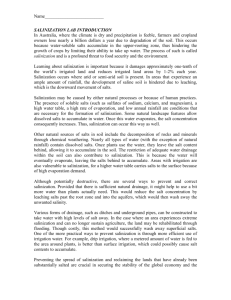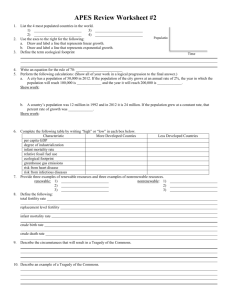Salinization Lab Salinization refers to a build up of salts in soil
advertisement
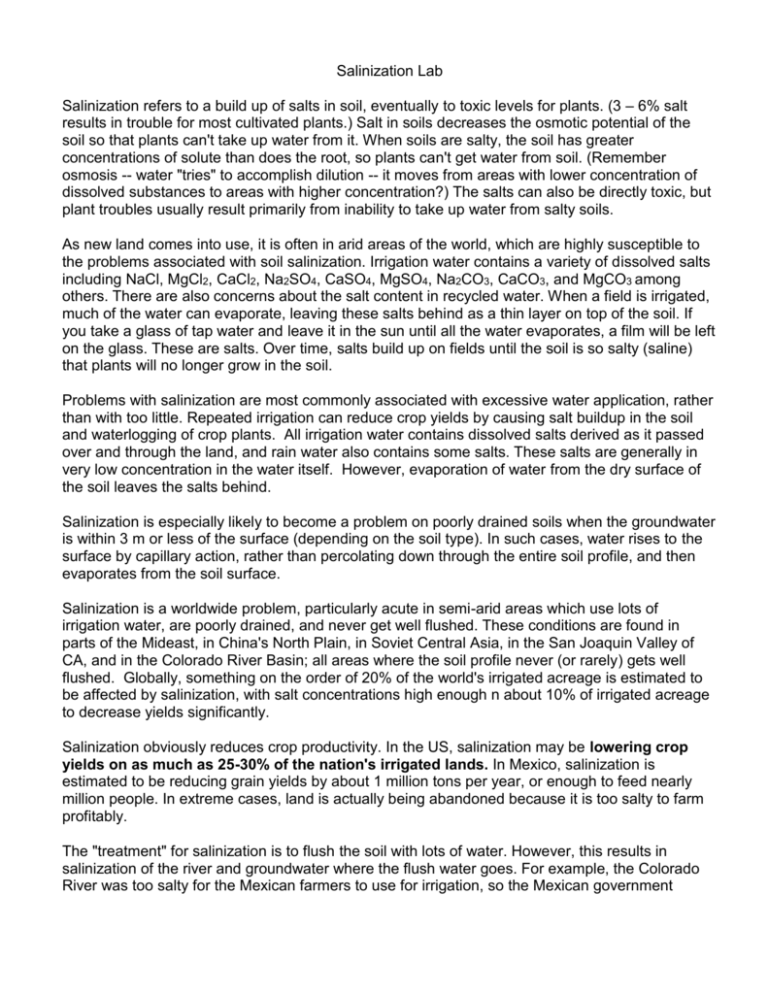
Salinization Lab Salinization refers to a build up of salts in soil, eventually to toxic levels for plants. (3 – 6% salt results in trouble for most cultivated plants.) Salt in soils decreases the osmotic potential of the soil so that plants can't take up water from it. When soils are salty, the soil has greater concentrations of solute than does the root, so plants can't get water from soil. (Remember osmosis -- water "tries" to accomplish dilution -- it moves from areas with lower concentration of dissolved substances to areas with higher concentration?) The salts can also be directly toxic, but plant troubles usually result primarily from inability to take up water from salty soils. As new land comes into use, it is often in arid areas of the world, which are highly susceptible to the problems associated with soil salinization. Irrigation water contains a variety of dissolved salts including NaCl, MgCl2, CaCl2, Na2SO4, CaSO4, MgSO4, Na2CO3, CaCO3, and MgCO3 among others. There are also concerns about the salt content in recycled water. When a field is irrigated, much of the water can evaporate, leaving these salts behind as a thin layer on top of the soil. If you take a glass of tap water and leave it in the sun until all the water evaporates, a film will be left on the glass. These are salts. Over time, salts build up on fields until the soil is so salty (saline) that plants will no longer grow in the soil. Problems with salinization are most commonly associated with excessive water application, rather than with too little. Repeated irrigation can reduce crop yields by causing salt buildup in the soil and waterlogging of crop plants. All irrigation water contains dissolved salts derived as it passed over and through the land, and rain water also contains some salts. These salts are generally in very low concentration in the water itself. However, evaporation of water from the dry surface of the soil leaves the salts behind. Salinization is especially likely to become a problem on poorly drained soils when the groundwater is within 3 m or less of the surface (depending on the soil type). In such cases, water rises to the surface by capillary action, rather than percolating down through the entire soil profile, and then evaporates from the soil surface. Salinization is a worldwide problem, particularly acute in semi-arid areas which use lots of irrigation water, are poorly drained, and never get well flushed. These conditions are found in parts of the Mideast, in China's North Plain, in Soviet Central Asia, in the San Joaquin Valley of CA, and in the Colorado River Basin; all areas where the soil profile never (or rarely) gets well flushed. Globally, something on the order of 20% of the world's irrigated acreage is estimated to be affected by salinization, with salt concentrations high enough n about 10% of irrigated acreage to decrease yields significantly. Salinization obviously reduces crop productivity. In the US, salinization may be lowering crop yields on as much as 25-30% of the nation's irrigated lands. In Mexico, salinization is estimated to be reducing grain yields by about 1 million tons per year, or enough to feed nearly million people. In extreme cases, land is actually being abandoned because it is too salty to farm profitably. The "treatment" for salinization is to flush the soil with lots of water. However, this results in salinization of the river and groundwater where the flush water goes. For example, the Colorado River was too salty for the Mexican farmers to use for irrigation, so the Mexican government forced the US to construct a desalinization plant near the Mexican border so the water would be useable. At times in summer, the Red River in TX and OK is saltier than seawater from its load of leached salts. In addition, the flushing is very hard on the soil structure. In extreme cases, when the salt crust is too thick, it can't be flushed, as water just runs off the salty surface. In this experiment, you will germinate seeds in varying degrees of salinity to determine the effect on the health of the plant. Abstract: Brief summary of the experiment and the results Introduction: Background information and the hypothesis Materials: 5 test tubes and a test tube rack 5 cotton balls Pipette Seeds Prepared salt solutions (5%, 4%, 3%, 2%, 1% and 0%) Deionized Water Parafilm Ruler Procedures: Day One: Set-up 1. Label each test tube with the concentration of the salt solution. The 0 % solution is the control. 2. Place a cotton ball in the test tube and pack it down. 3. Using the pipette and the different concentrations of salt water, moisten the cotton ball with enough water to saturate it, but do not leave any excess. 4. Place 2-4 seeds in each test tube. 5. Cover the test tubes with parafilm and place them in the rack. Place the test tube rack on one of the window sills. Day Two – Four: Observations 1. Record your observations. Make sure you note when the seed coat breaks, and the length of the roots and shoots. Discussion and Conclusions 1. What is the control group in this experiment? 2. What are the the independent and dependent variables in this experiment? 3. What is the relationship between the number of seeds which germinated and the concentration of the salt in the sample? 4. Did your experiment support your hypothesis? Explain. 5. Can you think of any errors that might have occurred that would invalidate your experiment? If so what were they and how might they be corrected? 6. Explain why increasing levels of salt concentrations affect seed growth and why irrigation seems to be the main cause of this. (Use other sources, if necessary, but cite them.) 7. Do you think all seeds would be affected in similar ways as the ones you used? 8. When soil becomes too salty, what are some methods of remediation?

